
|   |

|   |
Maharajah Serfoji II Jayanti - Prince Pratap Sinha Raje Bhosle e-mail: tanjorerajahserfoji2museum@gmail.com Photos courtesy: Prince Pratap Sinha Raje Bhosle October 26, 2020 King Serfoji II as Patron and Composer:  Antique portrait of King Serfoji II in Maharajah Serfoji II Memorial Hall, Sadar Mahal Palace, Thanjavur King Serfoji II was a great writer of many fine works, author of many Kathas and Natakas as well. He was master in the science and art of music and dance. He had himself composed special dance compositions in Marathi for being utilized in Bharatanatyam programs. An author of many sabda, varna, pada, svarajati, abinaya pada, tillana, gita, prabandha, kavuttuvam, alaru, jatis and korvais, he also patronised the famous nattuvanars during his lifetime, namely Gangaimuttu, Sabhapati, Subbayan, Ponnayya, Vadivelu, Chinnayya and Sundari. During his time, music and dance were viewed as regular careers. He started a school for imparting oriental learning and this was the 'Nava Vidya Kalanidhi.' The Sangeet Mahal was used for holding music concerts, dance performances and other artistic purposes. Sangeet Mahal was been allotted an amount in the state budget for its maintenance. One of his favorite court dancers named Sundari had the privilege to perform on Vijaya Dasami and was honoured with Rs.20 (those days it was a huge amount). She had also the unique honour of performing on special occasions like Navaratri, Diwali and so on. Lavani flourished during his reign. He was the composer and writer of many Lavani songs. His Devendra Kuravanji and Tristalli Tirthayatra Lavani are interesting compositions. His interest in western music, both in its theoretical and practical aspects, is also evident. Jayanti: 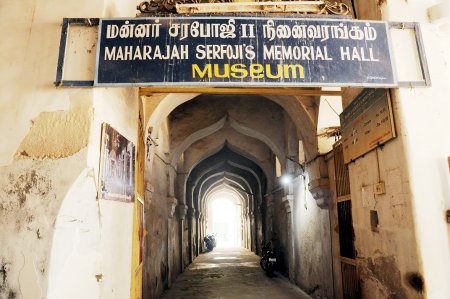

The 243rd birth anniversary of King Serfoji II was celebrated on 24th September 2020. As the sixth descendent of King Serfoji II, I invited Indian classical dancers to pay tribute by performing to compositions of Thanjavur Maratha kings or the Thanjavur Quartet. The tribute videos received from the dancers were posted on 'Maharajah Serfoji II Memorial Hall, Sadar Mahal Palace' Facebook page. The palace where I reside in Thanjavur, 'Sadar Mahal' was built by King Serfoji II in the year 1824 A.D under western engineering talent. It was his residential quarters and private darbar. Performing arts like drama, dance, music and other art forms were performed at the Sadar Mahal Palace. My grandfather H.H Prince Tulajendra Rajah P. Bhosle, 4th descendent of King Serfoji II, founded the Maharajah Serfoji II Memorial Hall Museum at Sadar Mahal in 1997. The online festival named 'Maharajah Serfoji II Jayanti' is a first of its kind initiative. The festival started with the live performance by Charumathi, granddaughter of K.P Kittapa Pillai, followed by the series of videos sent as tribute to the king. More than 45 artistes paid their tribute to the great scholar king.  Charumathi Charumathi presented Guru Sthuti, a composition of Thanjai Naalvar, Brahma Santhi Kowthuvam- a composition of Gangaimuthu nattuvanar, and a few songs from Sarabendra Bhoopala Kuravanji (written by Kottaiyur Sivakozhundhu Desikar, with music composed by Thanjai Naalvar. Kottaiyur Sivakozhundhu Desikar was a poet in the court of King Serfoji II. Charumathi's half an hour performance has reached 13000 plus views already. 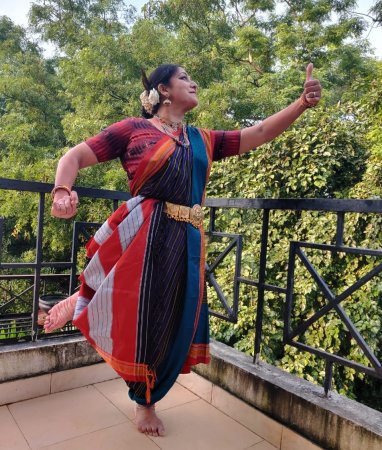 Arundathi Patwardhan Arundathi Patwardhan, daughter/disciple of Sucheta Bhide Chapekar, presented a unique Marathi composition of King Serfoji II that was choreographed by her mother, "Aathaa shabar houn jaatho mee thvareyne." It was an interesting padam which has a reference of Kiratarjuniya Puran. When Lord Shiva goes to the jungle in disguise of a hunter in order to humble Arjun, Parvati is also excited by the idea and entreats Lord Shiva to take her along. She says that she will be very happy to dress up like a huntress and accompany him. Shiva is little reticent in the beginning but finally succumbs to her wish. The mood of the song is very well expressed through the raga Senjuriti, tishra and chatushra gati, adi taal. 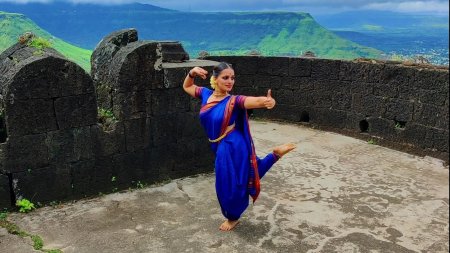 Lalan Desai Lalan Desai, disciple of Guru Sucheta Chapekar, presented a composition of King Serfoji II. In his nirupana "Nirguna swanubhava prathipaadanapoorvaka sagunpar upadesh" King Serfoji II beautifully conceptualized this composition in which the dancer/ narrator is proudly telling her sakhi, how a strong snake Adishesha, also fell short of words while narrating stories of Lord Shiva. This composition describes the mesmerizing victory of Lord Shiva over Tripurasura. How the whole earth becomes a chariot with Lord Brahma as a charioteer, four Vedas as 4 horses and sun-moon as its wheels. This composition further gives visuals of how the mountain Meru was used as a bow, Adishesha as a string and Lord Vishnu as an arrow. The choreography was by Guru Dr. Sucheta Chapekar. This composition is set in raag Nilambari and taal khanda jaati ata taal. The video was shot in Ajinkyatara Fort, Satara, Maharashtra. Ajinkyatara was the fourth capital of Marathas, the first one being Rajgad, followed by Raigad and then the fort of Jinji. Lakshmi Viswanathan presented a lecture demonstration video on "Nee saati dora," a composition of Ponnayya in ragam Bhairavi. The varnam celebrates the brilliance of the royal courtesan, who in turn extols the virtues of her beloved, the King of Thanjavur, Raja Serfoji II. The courtesan makes many passionate pleas of her burning desire for him, and the varnam vividly expresses those desires in poetic terms. The lecture was part of the Natya Darshan Conference 2018 convened by Priya Murle. Janani Mahalingam, disciple of Parshwanath Upadhye, presented Jakkini Daru written and composed by King Serfoji II in praise of Lord Shiva. 'Jakkini' is derived from Telugu word 'Jakkulu'. A Jakkini Daru is a rhythmic composition involving both nritta and nritya. The Jakkini Daru that Janani performed was in ragam Shankarabharanam and talam adi. Jakkini Daru usually portrays the integration of Hindustani and Carnatic elements. The inclusiveness of phrases like "Yellilam Yellilam" is perhaps from the influence of Mughal music traditions and culture at that period of time. It shows us a lot of inclusiveness and blending of various cultures as well. This was choreographed by Sucheta Chapekar. Sumedha Rane, disciple of Sucheta Chapekar and Alka Lajmi, performed to a Marathi composition composed by King Serfoji II - "Aghateeth saye Shiva leela, varnitha shesh hee baaghla." In the composition, Parvati describes to her sakhis, how Lord Shiva killed Tripurasura. Even the mighty Adishesha fell short of words to describe it. In the war, the earth became his chariot, four Vedas were the horses, the sun and moon became the two wheels and Lord Brahma was himself riding it. Shiva's bow was mount Meru and the arrow was Lord Vishnu himself. Thus equipped, Lord Shiva destroyed Tripurasura and removed the fears of his devotees. The story symbolizes the ultimate victory of good over evil. These verses bring out the veera and adbhuta rasa. 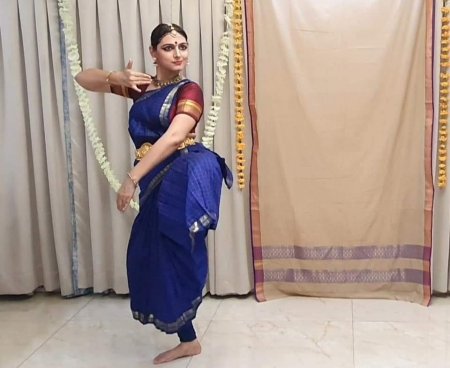 Apeksha Mundargi Apeksha Mundargi, another disciple of Guru Sucheta Chapekar and Alka Lajmi, presented a padam composed by Thanjavur Maratha King Shahaji II. "Konn kavaad ughadeetho" is a padam describing a playful dialogue between Lord Shiva and his better half Goddess Parvati. Young Parvati who is getting bored at home waiting for her husband to return, decides to play a prank on him and keeps him out of the locked door of their home. She deliberately interprets Lords Shiva's different names as excuse for not opening the door but when he introduces himself as Tyagesha, she seeks pardon and says, "I am young Gauri and I was just joking with you!" This padam is set in raag Kaafi, taal adi. Mumbai based dancer Sandhya Purecha and Pune based dance school Sneha Lalit Kala Kendra presented an innovative composition of King Serfoji II, "Chhangbhang thu karvooni ge," a swarajati in ragam Pantuvarali. It has 6 pairs of solfa sequence followed by lyrics stanza, that conjure Proudha Sakhi giving appropriate advise to her newlywed friend. Even in modern times, it is a precise counsel for winning the heart of husband and keeping it so. Sunitha Sivadas, senior Mohiniattam dancer, presented a padam "Aaji sonyatsa diwasa" written by King Serfoji II in Marathi. Through this padam he describes the vision he received of Lord Shiva. He says the day he saw Lord Sambashiva was a golden day in his life. The purpose of his life is fulfilled and it is his great luck and fortune to have witnessed not just Lord Sambashiva but also his two sons Karthikeya and Vinayaka along with his beautiful consort Goddess Parvati. The king ends the padam by seeking Lord Shiva to continue blessing and protecting him. This padam is composed in ragam Ritigowla and set to adi talam. Senior Bharatanatyam dancer Suman Badami and some other artistes also presented the same. 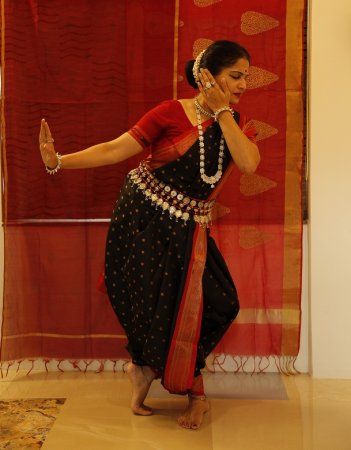 Rasika Gumaste Rasika Gumaste, disciple of Yogini Gandhi, presented a khandita nayika padam penned by King Serfoji II. "Sajani tyala neet vichari" is a Marathi song set to Carnatic music in which the nayika calls her sakhi and sarcastically tells her to ask Krishna if he has come to her by mistake, if he has lost his way. This is because she sees telltale marks on his body and feels cheated. She can't help but imagine what must've transpired between him and the other woman. Thinking of this makes her feel disgusted.. Krishna tries to sweet talk his way out but that makes her even more angry. Feeling extremely hurt, she tells him to leave. Smruti Vaghela presented a bhakti padam "Din mul daya kari" by King Shahaji II in ragam Madhyamavati and talam adi. Kuchipudi dancer Swaralee Bhope, disciple of Dr. Rajyalakshmi Seth, presented Ganesh Stuti, an invocation to Lord Ganesha in Daruvu format, in Telugu composed by Thanjavur Maratha Ruler, King Shahaji II, in ragam Hamsadhwani and talam adi. It was followed by Tulaja Sabdam (Mohana, adi) in praise of King Tulaja II, father of King Serfoji II. The lyrical lines praise his prowess in arts and letters and victoriously ruling Bhonsle Kingdom. According to information shared by Rajyalakshmi Seth, though no raga and tala was specified by Shahaji Maharaj, this composition was set to raga Hamsadhwani and adi talam by Dr. K. Uma Rama Rao (whose PhD topic was on Thanjavur Maratha King Shahaji II Yakshagana prabandhalu, 1994) and presented in Kuchipudi style on November 7, 1991 at Hyderabad for the first time. Regarding Tulaja Sabdam, it comes under royal category where compositions are written in praise of ruling kings. King Tulaja II was a patron of arts and literature. During his time, Natyacharya Subbaraya Voduvar received the king's patronage. Voduvar wrote various compositions such as varnams, sallam jatulu and swarajatulu and others. Pleased with his artistic abilities, King Tulaja II gifted him a building for dance activities. Tulaja Sabdam has a significant place both in Kuchipudi repertoire as well as in the syllabus of various academic courses. Archana, disciple of Kamakshi, presented a Marathi padam "Shiva Shiva tumhi kon sangaa" (Kaapi, misrachapu) composed by King Shahaji II. The nayika is having a conversation with the one who comes to visit her. She asks why he compares himself to Lord Tyagesa / Shiva. In the end she realizes that the visitor and the Lord are one and the same. Nithya and Vidya Ranganathan sang (Carnatic vocal) a pada written by King Shahaji II in Marathi language in praise of Lord Amritaghateshwara of Thirukkadaiyur. The lord is also known by the name Kala Samharamurthy. The composition has been tuned by Nithya Ranganathan in raga Kapi and taal adi. P. Nirmal Harish, disciple of Pattamal and Swetharanyam sisters (Nithya and Vidya) sang a composition of King Shahaji II in the raga Mukhari, tala misrachapu on Rathnagirishwara of Rathnagiri or Iyyarmalai. It was a Viraha padha in Telugu. 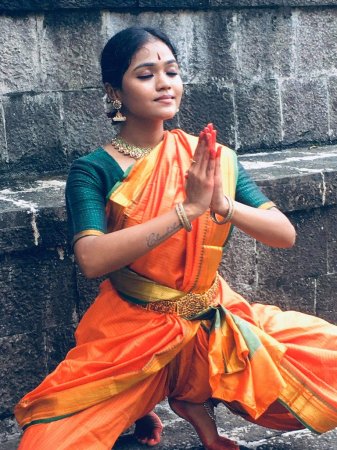 Vaishnavi Dhore Vaishnavi Dhore, student of Rama Vaidyanathan, performed a keerthanam "Perum kovil" composed by Tanjore Quartet, about the Brihadishwara temple in Thanjavur. It was in ragam Shri set to mishrachapu talam and choreographed by her guru Rama Vaidyanathan. This dance video was shot in Bhuleshwar temple in Pune, Maharashtra. That temple is said to have been built in 1200 by King Krishnadevaraya. The keertanam starts with a trikala jati in the square space - it is because in Brihadeshwara temple, the sanctum is placed at the centre of the western square space and outer wall has space for pradakshina. One more interesting thing is that the shikhara, a cubolic dome rests on a single block of granite, weighing 80 tons which sits above a 99ft square structure. Imagine how they must have hoisted such a huge weight in the 11th century without any machines. The protagonist of this piece is herself a dancer. The dancer is invoking god to give her laya, shruti and strength to dance in a proper way. Lord Shiva being the embodiment of knowledge, the dancer wants to imbibe that knowledge in the form of Karanas, dance and movement dynamics. 'My talam should be just perfect. Please give me the boon and blessing to follow the profession of arts,' says the dancer. S. Aishwarya and Soundarya, great grand daughters of M.S. Subbulakshmi, paid their tribute to the king by presenting (Carnatic vocal) a Tyagaraja kirti "Manavinaalakincha" in raga Nalinakaanti. Ishita Kulkarni, disciple of V. Soumyasri of Aurangabad, presented a popular Sabdam "Sarasi Jakshulu" (Ragamalika, mishrachapu), depicting the childhood leelas of Krishna composed by Vadivelu of the Tanjore Quartet. Senior Bharatanatyam dancer Padmini Radhakrishnan presented a composition of Ponniah Pillai, "Mayaa atheetha swaroopini nannu brovave, Maha Tripurasundari Sankari Gowri" in ragam Mayamalawa Gowlai and talam rupakam. Sharada Srinivasan, art historian and Archaeo-metallurgist performed a Tamil Shabdam "Tillai Ambalam" composed by the Tanjore Quartet. In this evocative piece, the Nayika speaks to her confidante about how she is enamoured of the Lord Nataraja who dances in Tillai Ambalam, Golden Hall of Chidambaram. She describes his awe inspiring dance, (arputa natanam) as he straddles the cosmos (gaganathil nindralam). His dance mesmerises even the deities who are well versed with musical instruments such as Krishna on the flute, Saraswati on the veena and with Nandi, the bull vahana, on the mridangam. The Nayika goes on to ask whether the lord whom she saw in her dreams would come to her. She asks her sakhi what is this yearning that moves her so much that it makes her waste away, and whether, like the flower that blooms under the sunlight, her devotion too would be rewarded and would reach the lord dancing in the ambalam. She asks whether the lord who dances within her would appear amongst the dancing processional troupe, the melam which was traditionally associated with temple worship. Thus the padam beautifully conveys the longing for mystical union at various levels, between the human, the cosmic and the divine. This Tamil padam in mishrachapu talam and Ragamalika was taught by Guru Bhanumati to Prof Sharada Srinivasan. Artistes also presented the following javalis. A composition of Chinnaiah, "Mutta vaddura Mohananga nannippudu" is a Telugu javali in ragam Saveri, set to adi talam. Here, the Nayika is upset with her lord for having spent good times with the other woman and asks him not to touch her with those hands which had touched the other woman. She is still in love with him even though she is hurt; she addresses him as Mohananga (handsome). The composer had dedicated this javali to the king and addressed him as "Shyama Bhoopala" in the last charanam. A javali composed by Chinnaiah, "Ne netlu sahintune" in which the Nayika says to Sakhi: "How can I bear this? How can I describe his love and beauty? He who fulfills every desire and is courageous in love, alas! He has entered the house of my rival. He has not come here yet. Of what use are these flowers and my youth? Who will appreciate them? Shyamendra has deserted me." Kanaka Sudhakar, senior dancer from Delhi, presented "Sarasi Jakshulu," a famous shabdam composed by Tanjore Quartet, set to Ragamalika and misrachapu talam. The bhakta presents the 'ninda stuti' bhav while narrating the playful antics of Lord Krishna. Ruchira Ingale from Satara, Maharashtra, disciple of Anchal Shanbhag Ghorpade, also presented this shabdam. Adhiti Venkat, disciple of Padma Subrahmanyam, presented "Kopametula," a composition of Chinniah. This javali set in ragam Kedaragowla and rupaka talam, describes the khandita nayika who is angry with her beloved and is not swayed by the hero's attempt to pacify her. Apoorva Jayaraman, disciple of Priyadarsini Govind, presented a javali "Mosa Jesene" by Chinnaiah Pillai of the Tanjore Quartet in ragam Sindubhairavi, talam rupakam. The nayika who is a mature woman, probably worldly wise, is cheated by her lover, someone she trusted and loved. After waiting for him to return for long periods, she tells her friend, 'Oh how he has cheated me; the many promises he made have all turned out empty.' She is not broken and depressed, but there is more of a tone of betrayal, hurt and bitterness in her voice and almost one of 'beware of that man.' In the charanam, she says, 'On the bed strewn with flowers, even as he embraced me, reminded of the other woman he swiftly got up and left... Such is that man, oh friend... Oh how he cheated me!' Madhuvanthi Sundararajan, disciple of Parimal Phadke, presented a javali, "Ela radayane Kamini" composed by Chinniah in Bhairavi, talam adi. Senior Bharatanatyam dancers Hema Rajagopalan, Rathna Kumar, Leela Samson, Amita Godbole etc paid their tributes. Vocalist Sudha Raghuraman, disciple and granddaughter of Guru O.V Subrahmaniam, sang a composition of Saint Annamacharya, "Bhavayami gopala balam" in ragam Yamuna Kalyani set to khandachapu talam. Videos of their performances can be seen on the museum's facebook page Prince Pratap Sinha Raje Bhosle, Sadar Mahal Palace, Thanjavur, is the 6th descendent of King Serfoji II. He is the author of 'Contributions of Thanjavur Maratha Kings with a Brief History of Cholas and Nayakas.' |